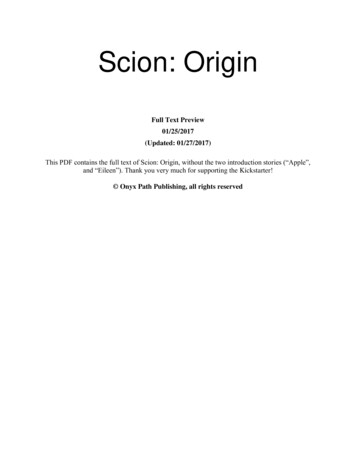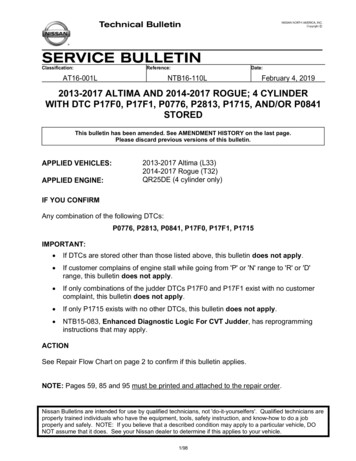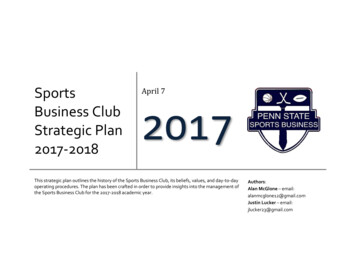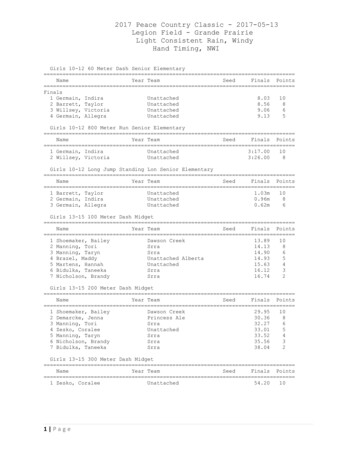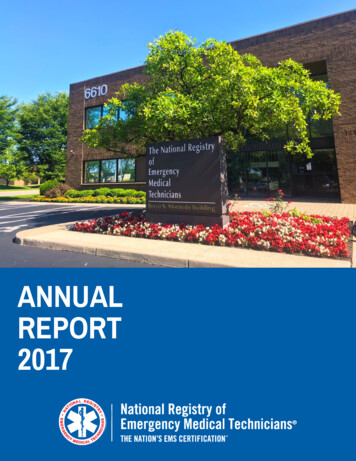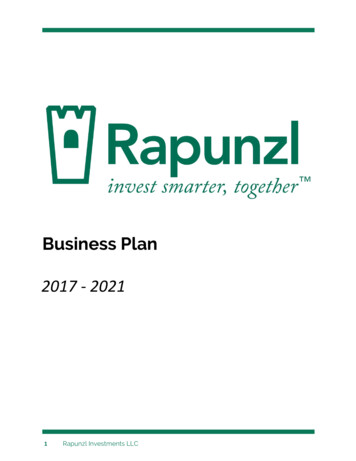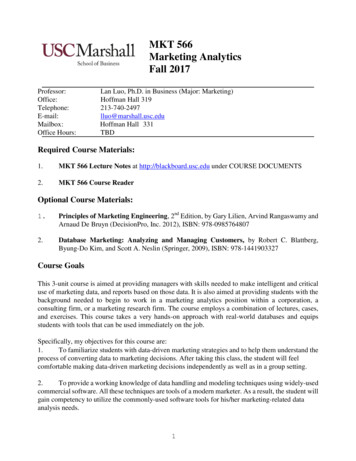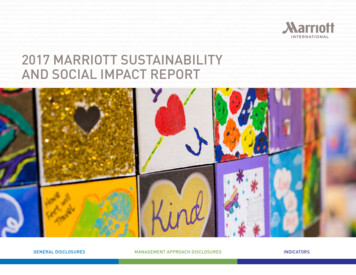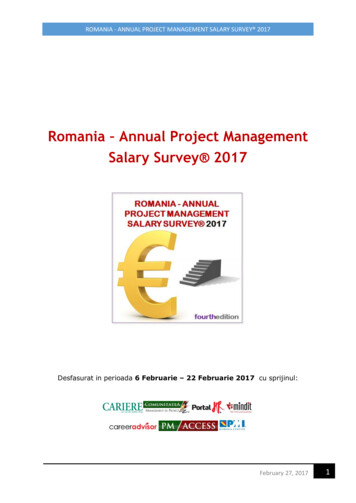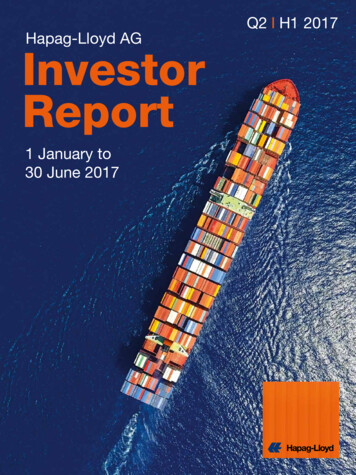
Transcription
Hapag-Lloyd AGInvestorReport1 January to30 June 2017Q2 I H1 2017
SUMMARY OF HAPAG-LLOYD KEY FIGURESKEY OPERATING FIGURES 1)Total vessels, of whichown vesselsleased vesselsQ2 2017Q2 2016H1 2017H1 201621917021917029%112701127060%8383167%% Change999799972%Aggregate capacity of vesselsTTEU1,5579521,55795264%Aggregate container capacityTTEU2,2871,5132,2871,5137%Bunker price (MFO, average for the period) 2)USD/t30018230018059%chartered vesselsBunker price (MDO, average for the period) 3)USD/tFreight rate (average for the %Transport volumeTTEU2,2871,8924,2213,70314%Revenuemillion USD2,6292,0884,9004,21216%Transport expensesmillion USD2,1301,8054,0363,56113%EBITDAmillion USD2538339321980%EBITmillion USD93– 5097– 44n.m.Group profit / lossmillion USD18– 111-49– 158n.m.Cash flow from operating activitiesmillion USD1747033222647%Investment in property, plant and equipmentmillion USD78115200220– 9%EBITDA margin (EBITDA / revenue)9.6%4.0%8.0%5.2%2.8 pptEBIT margin (EBIT / revenue)3.5%– 2.4%1.9%– 1.0%2.9 ppt18,02411,96518,02411,96551%KEY RETURN FIGURES 1)KEY BALANCE SHEET FIGURES AS AT 30 JUNE 4)Balance sheet totalmillion USDEquitymillion USD6,7635,3426,7635,34227%37.5%44.6%37.5%44.6%– 7.1 pptmillion USD11,2616,62411,2616,62470%Financial debtmillion USD8,3394,4158,3394,41589%Cash and cash equivalentsmillion USD86060286060243%Net debt (financial debt – cash and cash equivalents) 5)million .5 ppt1,3208021,32080265%Equity ratio (equity / balance sheet total)Borrowed capitalKEY FINANCIAL FIGURES AS AT 30 JUNE 4)Gearing (net debt / equity)Liquidity reserveNUMBER OF EMPLOYEES AS AT 30 JUNE1,6751,4981,6751,49812%Employees on land10,9107,80710,9107,80740%HAPAG-LLOYD TOTAL12,5859,30512,5859,30535%Employees at sea) The comparison of figures refers to the prior year period 1.1.-30.6.2016MFO Marine Fuel Oil3)MDO Marine Diesel Oil4)The comparison of figures refers to the balance sheet date 31.12.20165)incl. Restricted Cash booked as other assets: USD 71.6 million as of 30.06.2017, USD 19.7 million as of 31.12.201612)The UASC Group has been included in Hapag-Lloyd AG’s consolidated financial statements from the date control was transferred on 24 May 2017.The presented figures include the effects of the transaction from thisdate and can therefore only be compared to the prior year’s figures to alimited extent.Disclaimer: This half-year financial report contains statements concerning future developments at Hapag-Lloyd. Due to market fluctuations, the development of the competitive situation, world marketprices for commodities, and changes in exchange rates and the economic environment, the actual results may differ considerably from these forecasts. Hapag-Lloyd neither intends nor undertakesto update forward-looking statements to adjust them for events or developments which occur after the date of this report. UASC’s Ltd. and its subsidiaries (in the following mentioned as UASCGroup as well) have been included in the figures from the date control was transferred on 24 May 2017.The key figures used are therefore only comparable with the previous year to a limited extent.This report was published on 29 August 2017.
Q 2 / H 1 2017 I I NV E S TO R R EP O R TCONTENTS1. Highlights 52. Sector-specific conditions 63. Structure of Hapag-Lloyd’s vessel and container fleet 74. Group earnings position 84.1Freight rate per trade 84.2Transport volume per trade 94.3Revenue per trade 94.4Consolidated income statement 104.5Transport expenses 114.6Earnings position 135. Group net asset position 6. Group financial position 6.1Developments in cash and cash equivalents 6.2Financial position 7. Events after the balance sheet date 14161617198. Revised outlook 199. Combined entity 2110. Financial calendar 2017 2611. Disclaimer 273
I N V E S T O R R EP O R T I Q2 / H 1 2017IMPORTANT NOTICEUASC Ltd. and its subsidiaries (UASC Group) were consolidated on 24 May 2017 and are included in the consolidated financial statements of Hapag-Lloyd AG as at 30 June 2017. This enlarged the group of consolidatedsubsidiaries from 82 companies to 181 companies. As such, the net asset, financial and earnings positionfigures for the first half of 2017 can only be compared with those of previous years to a limited extent. Thispertains to the Group’s net asset and financial position in particular.Unless stated otherwise, the figures for the first half of 2016 relate to Hapag-Lloyd not including the UASC Group.The information provided in this Investor Report is based on a calculation of US dollar figures, derived fromthe figures published in EUR within the respective Interim or Annual Report of Hapag-Lloyd AG (available financial-report.html).The US dollar figures presented herein have not been reviewed by auditors and are supplemental informationto the respective Interim or Annual Report of Hapag-Lloyd AG for capital market participants. The respectiveInterim and Annual Reports of Hapag-Lloyd AG remain the prevailing and legally binding documents.Hapag-Lloyd AG conducts its container shipping business in an international business environment in whichtransactions are invoiced mainly in US dollars and payment procedures are handled in US dollars. This relatesnot only to operating business transactions, but also to investment activities, an example being the purchase,chartering and rental of vessels and containers, as well as the corresponding financing of investments.Therefore, the functional currency of Hapag-Lloyd AG is the US dollar. However, the reporting currency ofHapag-Lloyd AG is the euro.For reconciliation to the Interim Report H1 2017, please find below the respective exchange rates: Values for Q1 2016 have been converted at the respective Q1 2016 exchange rates Values for Q2 2016 have been calculated by subtracting the Q1 2016 figures from the H1 2016 figures Values for H1 2016 have been converted at the respective H1 2016 exchange rates Values for Q1 2017 have been converted at the respective Q1 2017 exchange rates Values for Q2 2017 have been calculated by subtracting the Q1 2017 figures from the H1 2017 figures Values for H1 2017 have been converted for Hapag-Lloyd (excl. UASC) at the average exchange rate forJanuary to June 2017 and for UASC since consolidation 24 May 2017 at the average exchange rate forJune 2017.EXCHANGE RATESClosing rateper EURUS dollars30.06.20171.1405Average rate31.03.2017 30.06.20161.06811.1146HLAG AGUASC GroupH1 2017June 17Q1 2017H1 2016Q1 20161.08261.12371.06511.11271.103This report contains statements concerning future developments at Hapag-Lloyd AG. Due to market fluctuations, the development of the competitive situation, market prices for commodities, and changes in ex change rates and the economic environment, the actual results may differ considerably from these forecasts.Hapag-Lloyd AG neither intends nor undertakes to update forward-looking statements to adjust them forevents or developments, which occur after the date of this report.4
Q 2 / H 1 2017 I I NV E S TO R R EP O R T1. HIGHLIGHTS The merger with UASC was successfully completed on 24 May 2017 and is expected to provide thefollowing advantages:o Strengthened market position as one of the top five players of a container shipping industry whichcontinues to consolidateo Enhanced market presence in attractive Middle East trade and solid position in all tradeso Efficient and young fleet with a low level of investment needed in the futureo Annual synergies of USD 435 million fully starting in 2019, strong ramp up already in 2018o Strong partner in THE Allianceo Strong organic increase in transport volume of 7.3% in H1 2017. UASC added 248 TTEU of transportvolume since first time consolidation Following the acquisition of UASC and reflecting the first optimisation of the combined fleet Hapag-Lloyd’sfleet comprised 219 container ships as at 30 June 2017. The TEU capacity of the entire Hapag-Lloyd fleetincreased to 1,557,013 TEU Moderate recovery of freight rate gains continues in Q2 2017. H1 2017 freight rate of 1,068 USD/TEUexceeds previous year’s level. Including UASC the combined freight rate stands at 1,056 USD/TEU Transport expenses (excl. bunker cost) increase less than volume growth as a result of further cost savings, e.g. by replacing charter agreements by more favourable contracts and benefitting from additional synergies and savings from cost cutting measures that have now been implemented in full UASC integration is well on track with sizeable initial optimisation measures already implemented in theareas of network and ship systems. Following the completed takeover of UASC’s container shipping activities, Hapag-Lloyd will not invest in new ship systems in the next few years. The joint fleet shouldmake it possible to utilise the medium-term expansion opportunities resulting from market growth and torealise economies of scale in ship operations The first-time consolidation of UASC generated one-off income of USD 52.3 million at Hapag-Lloyd. Atthe same time, costs for implementing the restructuring of the UASC Group in relation to the operationalintegration of UASC’s business activities into Hapag-Lloyd totalled USD 46.0 million Clearly positive EBITDA of USD 393.1 million in first six months of 2017 (H1 2016: USD 218.8 million) Positive EBIT of USD 96.5 million clearly above previous year’s level (H1 2016: USD – 44.2 million) Strong liquidity reserve totalled USD 1.3 billion (as at 30 June 2017) Equity ratio decreases to 37.5% due to the substantial increase of the balance sheet total5
I N V E S T O R R EP O R T I Q2 / H 1 20172. SECTOR-SPECIFIC CONDITIONSThe experts at the International Monetary Fund (IMF) anticipate global economic growth of 3.5% in 2017, followed by stronger global growth of 3.6% in 2018 (IMF, World Economic Outlook, July 2017). The forecastedeconomic growth remained unchanged from the forecast published in April 2017.According to the IMF, the volume of global trade, which is key to the demand for container shipping services,will increase by 4.0% in the current year (IMF, World Economic Outlook July 2017: 3.8%). Growth of 3.9% isexpected in 2018.DEVELOPMENTS IN GLOBAL ECONOMIC GROWTH (GDP),WORLD TRADING VOLUME AND GLOBAL CONTAINER TRANSPORT VOLUME201520162017e2018eGlobal economic growth3.43.23.53.6World trading volume (goods and services)2.62.34.03.9Global container transport volume1.13.24.64.9in %Source: IMF August 2017, IHS Global Insight May 2017Based on the current forecasts, the global cargo volume could rise to 139 million TEU in 2017 (IHS GlobalInsight, May 2017). IHS Global Insight expects the global container shipping volume to increase by 4.6% in2017, outpacing the forecast rate of growth for global trade. For the period 2018 to 2021, IHS Global Insightis predicting annual growth of between 4.7% and 4.9% in the global container shipping volume.At the beginning of 2017, the aggregate capacity of the global container ship fleet was approximately 20 millionTEU (Drewry Container Forecaster Q2 2017, June 2017). Based on the container ships on order and planneddeliveries, the globally available transport capacity should see increases of around 1.1 million TEU in 2017and around 1.5 million TEU in 2018 (Drewry Container Forecaster Q2 2017, June 2017). This includes theexpected delays of deliveries in the current financial year. The tonnage of the commissioned container ships ofapproximately 2.9 million TEU (MDS Transmodal, July 2017) is equivalent to around 14% of the present globalcontainer fleet’s capacity (approximately 20 million TEU). It therefore remains well below the highest level seento date, which was around 56% in 2008. In the period from January to June 2017, orders were placed forthe construction of 38 container ships with a transport capacity totalling approximately 37,600 TEU (FY 2016:capacity of 0.2 million TEU [Clarksons Research, July 2017]).GLOBAL CAPACITY DEVELOPMENT 1)201520162017e2018e11589Delayed deliveries2021Scrappings13328135in %Scheduled capacity growthCapacity measuresNet capacity growthBased on current orderbook and predictions for scrappings and postponed deliveriesSource: Drewry Container Forecaster Q2 20171)6
Q 2 / H 1 2017 I I NV E S TO R R EP O R TBased on figures from MDS Transmodal, a total of 70 container ships with a transport capacity of a pproximately578,000 TEU were placed into service in the first six months of 2017 (H1 2016: 77 ships with a transportcapacity of approximately 518,000 million TEU). In the future, the actual growth in the global container shipfleet’s transport capacity is expected to be lower than the projected nominal increase, as old and inefficientships are scrapped, deliveries of newbuilds are postponed and slow steaming (reducing the speed at whichservices operate) is used. According to Drewry (Container Forecaster Q2 2017), the scrapping of inefficientships reached a record high of 659,000 TEU in 2016 (2013: 444,000 TEU). Drewry expects 500,000 TEU tobe scrapped in 2017.Idle capacity fell to around 0.5 million TEU at the end of June 2017 – approximately 69% lower than the currentrecord of around 1.6 million TEU recorded in October 2016 (Alphaliner, Weekly Issue 29, July 2017). This reduction stemmed from the large number of vessels which were scrapped and the rise in demand for charteredships. The majority of idle ships have a capacity of up to 5,100 TEU.3. STRUCTURE OF HAPAG-LLOYD’S VESSEL AND CONTAINER FLEETSTRUCTURE OF HAPAG-LLOYD‘S VESSEL AND CONTAINER FLEET 1)Number of vesselsAggregate capacity of vessels (TTEU)thereofNumber of own vesselsAggregate capacity of own vessels (TTEU)Number of leased vesselsAggregate capacity of leased vessels (TTEU)Number of chartered vesselsAggregate capacity of chartered vessels (TTEU)Aggregate container capacity (TTEU)Number of ,58311870519312974211,513128 The figures for 30.06.2017 relate to Hapag-Lloyd’s fleet including the business activities acquired from UASC. The figures for 31.12.2016and 30.06.2016 relate to Hapag-Lloyd only and do not include UASC’s container shipping activities.Following the acquisition of UASC and reflecting first optimisation measures, Hapag-Lloyd’s fleet comprised219 container ships as at 30 June 2017. The TEU capacity of the entire Hapag-Lloyd fleet increased to1,557,013 TEU. As a result of the merger with UASC, the share of ships owned outright based on TEU capacityincreased to approximately 68% as at 30 June 2017 (H1 2016, without the UASC Group: approximately 57%).The average age of the ships (capacity-weighted) was 7.1 years. The average ship size within the Hapag-LloydGroup fleet is 7,110 TEU, which is approximately 27% above the comparable average figure for the ten largestcontainer liner shipping companies and around 83% above the average ship size in the global fleet (H1 2017:3,893 TEU). The container capacity also increased substantially as a result of the merger with UASC. As at30 June 2017, Hapag-Lloyd owned or rented 1,398,327 containers with a capacity of 2,286,955 TEU forshipping cargo. The capacity-weighted share of containers owned by the Group increased to around 67% asat 30 June 2017 (H1 2016, without the UASC Group: approximately 43%). Furthermore, the service structures7
I N V E S T O R R EP O R T I Q2 / H 1 2017of both companies have already been merged and the first steps towards optimising the new structures havetaken place. As at 30 June 2017, Hapag-Lloyd (with the UASC Group) now offers over 129 services. Prior tothe merger, Hapag-Lloyd had a global network of 118 services (31 March 2017). UASC offered its customersa network of 45 services.In the first half of 2017, Hapag-Lloyd used three chartered ships to reposition empty containers. Together, thevessels had a capacity of 10,611 TEU. As the ships were not employed in a liner service, they are not includedin the above fleet data.The final vessel from Hapag-Lloyd’s original order book of five container ships, each with a capacity of 10,500TEU (incl. 2,100 slots for reefer containers), was delivered in April 2017. One of two ships from UASC’s currentorder book with a capacity of 15,000 TEU each will be delivered to Hapag-Lloyd on 27 July 2017. The secondship will be delivered in the second half of 2017.4. GROUP EARNINGS POSITION4.1 Freight rate per tradeNot including the UASC Group, the average freight rate in the first six months of 2017 was USD 1,068/TEU andwas therefore USD 26/TEU (2%) up on the prior year period (USD 1,042/TEU). Freight rate increases in the FarEast, Middle East, Intra-Asia and Latin America trades had a positive impact on the rate level in the first half of2017. However, as competition remains intense, the freight rate increases announced in a number of tradescould not be fully implemented. The main reason for this was the persistently difficult market environment, withpressure on freight rates continuing.The UASC Group was included in the consolidated financial statements as at 24 May 2017. The average freightrate for the acquired UASC Group activities since this date was USD 870/TEU.FREIGHT RATE PER TRADE 1)USD/TEUQ2 2016 QoQ % YoY %change change1,3190%– 2%1,2234%4%71912%40%68929%48%965–1%4%56313%8%H1 2017H1 %change– 4%– ceania)1,0481,0091,0644%– 2%1,0301,071– 4%Total Hapag-Lloydexcluding UASC Group(weighted average)UASC GroupTotal (weighted AtlanticTranspacificFar EastMiddle EastLatin AmericaIntra-AsiaEMAO1)8Q2 2017 Q1 2017I n connection with the merger of the UASC group, the trades have been restructured and the assignment of individual services amended.The prior period figures have been amended accordingly.
Q 2 / H 1 2017 I I NV E S TO R R EP O R T4.2 Transport volume per tradeThe transport volume performed particularly well in the first six months of the 2017 financial year. Hapag-Lloyd(without the UASC Group) was able to increase its transport volume by 270 TTEU to 3,973 TTEU (prior year period:3,703 TTEU) as a result of its balanced positioning in all trades. This growth of 7.3% was higher than the predictedoverall market trend (source: Clarkson Research, July 2017). All of the trades contributed to this positive performance. The inclusion of the UASC led to a further rise in the transport volume of 248 TTEU since consolidation,resulting in a total transport volume of 4,221 TTEU ( 14.0%) in the first half of 2017 (prior year period: 3,703 TTEU).TRANSPORT VOLUME PER TRADE 1)TTEUAtlanticTranspacificFar EastMiddle EastLatin ica–Oceania)Total Hapag-Lloydexcluding UASC GroupUASC GroupTotal1)Q2 2017 Q1 2017Q2 2016 QoQ % YoY %change change3988%6%365– 3%2%2019%16%114– 3%4%5519%10%1574%1%H1 2017H1 ,892n.a.1,8925%n.a.18%8%n.a.21%3,9732484,2213,703 7.3%n.a.n.a.3,703 14.0%I n connection with the merger of the UASC group, the trades have been restructured and the assignment of individual services amended.The prior period figures have been amended accordingly.4.3 Revenue per tradeNot including the UASC Group, the Hapag-Lloyd Group’s revenue increased by USD 474.3 million to USD4,686.5 million in the first half of 2017 (prior year period: USD 4,212.2 million). With the inclusion of the UASCGroup as at 24 May 2017, revenue increased by an additional USD 213.2 million. As a result, revenue rose inthe first half of 2017 to USD 4,889.7 million overall (prior year period: USD 4,212.2 million).REVE
Bunker price (MDO, average for the period) 3) USD/t 473 375 471 372 27% Freight rate (average for the period) USD/TEU 1,064 1,019 1,056 1,042 1% Transport volume TTEU 2,287 1,892 4,221 3,703 14% Revenue million USD 2,629 2,088 4,900 4,212 16% Transport expenses million USD 2,130 1,805 4,036 3,561 13% EBITDA
